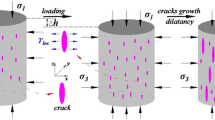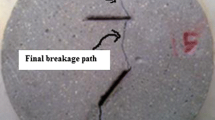Abstract
We present a statistical model which is able to capture some interesting features exhibited in the Brazilian test of rock samples. The model is based on elements which break irreversibly when the force experienced by the elements exceed their own load capacity. If an element breaks the load capacity of the neighboring elements are decreased by a certain amount, assuming weakening effect around the defected zone. From the model we numerically investigate the stress-strain behavior, the strength of the system, how it scales with the system size and also its fluctuation for both uniform and Weibull distribution of breaking thresholds in the system. To check the validity of our statistical model we perform few Brazilian tests on Sandstone and Chalk samples. The stress-strain curve from model results agree qualitatively well with the lab-test data. Also, the damage profile right at the point when the stress-strain curve reaches its maximum is seen to mimic the crack patterns observed in our Brazilian test experiments.
Similar content being viewed by others
References
D. Li, L.N.Y. Wong, Rock Mech. Rock Eng. 46, 269 (2013)
M. Cai, P.K. Kaiser, Int. J. Rock Mech. Min. Sci. 41, 478 (2004)
N. Erarslan, D.J. William, Int. J. Rock Mech. Min. Sci. 49, 21 (2012)
M.K. Fahad, J. Mat. Sci. 31, 3723 (1996)
F.L.L.B. Carneiro, in Proceedings of the 5th meeting of the Brazilian Association for Technical Rules (1943), 3d. section
T. Akazawa, J. Japan Soc. Civil Eng. 29, 777 (1943)
ISRM, Int. J. Rock. Mech. Min. Sci. Geomech. Abstr. 15, 99 (1978)
N.D.J. Simpson, A. Stroisz, A. Bauer, A. Vervoort, R.M. Holt, American Rock Mechanics Association 14, 7399 (2014)
M. Cai, Rock Mech. Rock Eng. 46, 289 (2013)
D.F. Malan, J.A.L. Napier, B.P. Watson, Int. J. Rock Mech. Min. Sci. Geomech. Abstr. 31, 581 (1994)
W.C. Zhu, C.A. Tang, Int. J. Rock Mech. Min. Sci. 43, 236 (2006)
A. Hansen, P.C. Hemmer, S. Pradhan, The Fiber Bundle Model: Modeling Failure in Materials (Wiley-VCH, Berlin, 2015)
S. Pradhan, B.K. Chakrabarti, A. Hansen, Rev. Mod. Phys. 82, 499 (2010)
C. Roy, S. Kundu, S.S. Manna, Phys. Rev. E 87, 062137 (2013)
G. Barla, N. Innaurato, Rock Mech. Rock Eng. 5, 215 (1973)
Author information
Authors and Affiliations
Corresponding author
Rights and permissions
About this article
Cite this article
Kundu, S., Stroisz, A. & Pradhan, S. A simple discrete-element-model of Brazilian test. Eur. Phys. J. B 89, 130 (2016). https://doi.org/10.1140/epjb/e2016-60915-y
Received:
Revised:
Published:
DOI: https://doi.org/10.1140/epjb/e2016-60915-y




